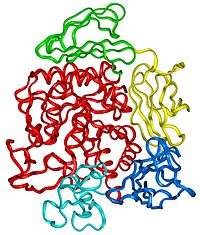Cyclodextrin glycosyltransferase

Cyclodextrin glycosyl transferase (also Cyclodextrin glucosyltransferase or Cyclodextrin glucanotransferase) or CGTase for short (EC 2.4.1.19) is a bacterial enzyme belonging to the same family of the α-amylase specifically known as glycosyl-hydrolase family 13. This peculiar enzyme is capable of catalyzing more than one reaction with the most important being the synthesis of non-reducing cyclic dextrins known as cyclodextrins starting from starch, amylose, and other polysaccharides. CGTase is an enzyme common to many bacterial species, in particular of the Bacillus genus (e.g. B. circulans, B. macerans and B. stearothermophilus), as well as to some archaea, but it is not known to be present in any other species.
Catalytic activities
All of the CGTases can catalyze up to four reactions: cyclization, coupling, disproportionation and hydrolysis. All these activities share the same catalytic mechanism which is common to all glycosyl-hydrolases.
Cyclization is the process through which a linear polysaccharidic chain is cleaved and the two ends of the cleaved fragment are joined to produce a circular dextrin (cyclodextrin or CD): on the basis of the number of sugar residues this circular product is made of three main type of cyclodextrins can be distinguished, α-CD with six residues, β-CD with seven residues and γ-CD with eight residues.
The coupling reaction can be easily described as the reverse process of cyclization: the enzyme cleaves a cyclodextrin to produce a linear dextrin which is subsequently joined to a linear oligosaccharide.
Disproportionation is very similar to coupling, but the cleaved dextrin is not a cyclodextrin, but a linear oligosaccharide that is then joined to a second oligosaccharide.
CGTase also has a weak hydrolyzing activity which consists in cleaving the longer polysaccharidic chains into shorter fragments.
References
- Biwer A, Antranikian G, Heinzle E. Enzymatic production of cyclodextrins. Appl Microbiol Biotechnol 2002;59:609-17. PMID 12226716.
- van der Veen BA, Uitdehaag JC, Penninga D, van Alebeek GJ, Smith LM, Dijkstra BW, Dijkhuizen L. Rational design of cyclodextrin glycosyltransferase from Bacillus circulans strain 251 to increase alpha-cyclodextrin production. J Mol Biol 2000;296:1027-38. PMID 10686101.